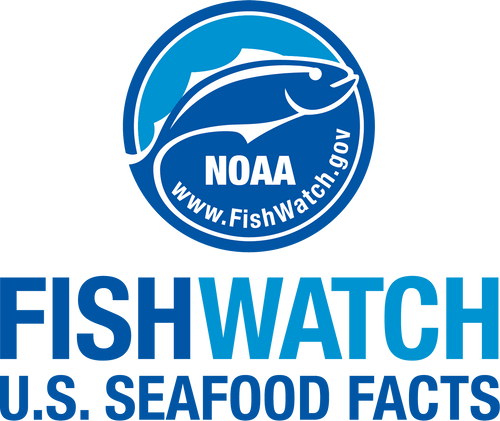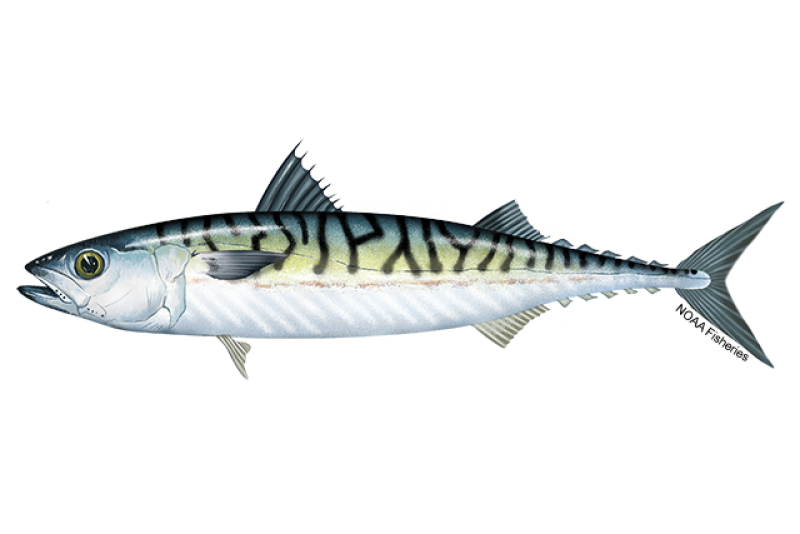 Pacific mackerel. Credit: Shutterstock
Pacific mackerel. Credit: Shutterstock
Pacific mackerel. Credit: Shutterstock
About the Species
 Pacific mackerel. Credit: Shutterstock
Pacific mackerel. Credit: Shutterstock
Pacific mackerel. Credit: Shutterstock
U.S. wild-caught Pacific mackerel is a smart seafood choice because it is sustainably managed and responsibly harvested under U.S. regulations.

Population
The stock is not overfished.

Fishing Rate
Not subject to overfishing.

Habitat Impact
The gear used to catch Pacific mackerel is used at the surface and has little impact on bottom habitat.

Bycatch
Bycatch is low because gear used is selective.
Population Status
- Pacific mackerel is not overfished (2023 stock assessment), and not subject to overfishing based on 2022 catch data. Summary stock assessment information can be found on Stock SMART.
- Pacific mackerel naturally experience “boom and bust” cycles of abundance, which is typical of other small pelagic species that have relatively short life spans and high reproduction rates.
- The Pacific mackerel stock is well above its target population level. However, in historical terms, the population remains at a relatively low abundance level, due primarily to oceanographic conditions.
Appearance
- The body of the Pacific mackerel tapers at both ends.
- They have a pointy head and a large mouth.
- The head is dark blue, the back is dark blue with about 30 dark wavy lines, and the undersides are silver green.
- Pacific mackerel can be distinguished from other mackerel by counting the finlets on their back; Pacific mackerel typically have four to six finlets.
Biology
- Pacific mackerel grow fast, up to 25 inches and more than 6 pounds.
- They can live up to 18 years but are able to reproduce by age 4, and sometimes as early as age 1.
- They spawn at different times of the year, depending on where they live. Pacific mackerel spawn from late April to September off California, year-round off central Baja California peaking from June through October, and from late fall to early spring off Cabo San Lucas.
- They spawn several times a year, releasing batches of almost 70,000 eggs each time. The eggs usually hatch within 4 to 5 days.
- Pacific mackerel feed on plankton (tiny floating plants and animals) and the younger stages of all the pelagic species such as anchovies and sardines, as well as their own young.
- Various larger fish (such as sharks and tunas), marine mammals, and seabirds eat Pacific mackerel.
- Pacific mackerel school as a defense against predators. Often they will school with other pelagic species such as jack mackerel and sardines.
- As adults, they migrate north to Washington in the summer and south to Baja California in the winter. The northerly movement in summer is accentuated during El Niño events.
- They also travel inshore and offshore off California—they’re more abundant inshore from July to November and more abundant offshore from March to May.
Where They Live
Range
- Pacific mackerel are found from southeastern Alaska to Mexico but are most common south of Point Conception, California.
Habitat
- Pacific mackerel live within 20 miles of shore in water ranging from 50˚ to 72˚ F.
- When the population is small, they tend to occupy only the warmer part of their habitat.
- Juveniles live off sandy beaches, around kelp beds, and in open bays.
- Adults are found near shallow banks from the surface to waters almost 1,000 feet deep.
Fishery Management
- NOAA Fisheries and the Pacific Fishery Management Council manage the Pacific mackerel fishery.
- Managed under the Coastal Pelagic Species Fishery Management Plan:
- Catch limits are in place to end and prevent overfishing.
- Permits are needed to harvest Pacific mackerel.
- Gear restrictions are in place to reduce bycatch.
Harvest
- Commercial fishery:
- In 2023, commercial landings of Pacific mackerel totaled 1.6 million pounds and were valued at $400,000, according to the NOAA Fisheries commercial fishing landings database.
- There is no directed fishery for mackerel in Oregon or Washington, but small amounts are taken incidentally by whiting trawlers and salmon trollers.
- Gear types, habitat impacts, and bycatch:
- Round haul nets are used to catch Pacific mackerel.
- Habitat and bycatch impacts are minimal because the gear is used at the surface.
- Recreational fishery:
- Recreational fishermen catch Pacific mackerel in California but seldom target them.
- The statewide recreational harvest makes up a small fraction (less than 5 percent in weight) of the total landings.
- California’s recreational catch of Pacific mackerel is included within the fishery harvest guideline, but there are no other restrictions on this fishery.
Last updated by NOAA Fisheries on 04/02/2025
Featured News
 The sunset glows as the ship pulls the MFT through calm waters. Photo Credit Greg Shaughnessy
The sunset glows as the ship pulls the MFT through calm waters. Photo Credit Greg Shaughnessy
 NOAA Ship Reuben Lasker, a fisheries survey vessel, departed San Diego in early July to assess coastal pelagic species such as sardine and anchovy. Credit: Paul Hillman/NOAA Fisheries
NOAA Ship Reuben Lasker, a fisheries survey vessel, departed San Diego in early July to assess coastal pelagic species such as sardine and anchovy. Credit: Paul Hillman/NOAA Fisheries
California Current Fish Surveys Resume with 3-Month Assessment of Sardine, Anchovy, and Mackerel
 Chef Rob's Pulled Opah Sandwich. Credit: Sam Wells.
Chef Rob's Pulled Opah Sandwich. Credit: Sam Wells.
Seafood Facts

Is Pacific Mackerel Sustainable?
U.S. wild-caught Pacific mackerel is a smart seafood choice because it is sustainably managed and responsibly harvested under U.S. regulations.
Availability
Year-round, but primarily in summer.
Source
U.S. wild-caught from Washington to California.
Taste
Rich with a pronounced flavor.
Texture
Flaky and moist.
Color
Dark red flesh.
Health Benefits
Pacific mackerel is a good source of riboflavin and vitamin B6, and a very good source of protein, niacin, vitamin B12, selenium, and omega-3 fatty acids.
Nutrition Facts
Servings: 1; Serving Weight: 100 g; Calories: 158; Protein: 20.07 g; Total Fat: 7.89 g; Total Saturated Fatty Acids: 2.247 g; Carbohydrate: 0 g; Total Sugars: 0 g; Total Dietary Fiber: 0 g; Cholesterol: 47 mg; Selenium: 36.5 mcg; Sodium: 86 mgMore Information
Mackerel Recipes
Need some cooking inspiration to incorporate mackerel into your rotation? Browse these recipes for grilled herb-broiled mackerel, pasta with mackerel, and more!

Last updated by NOAA Fisheries on 04/02/2025
Seafood News
 Fresh-caught taʻape on ice. Credit: Conservation International Hawaiʻi.
Fresh-caught taʻape on ice. Credit: Conservation International Hawaiʻi.
Reducing Waste and Feeding Communities in Hawaiʻi with a Whole Fish Approach
 Chef Tyler Hadfield’s Curried Skate Wings with Tomato-Masala Chutney
Chef Tyler Hadfield’s Curried Skate Wings with Tomato-Masala Chutney
Ring In the New Year With These Crowd-Favorite Seafood Recipes
 NOAA Fisheries, in collaboration with Blue Ocean Mariculture, is conducting a multi-year pilot study to evaluate observational methods and tools for studying Hawaiian monk seal behavior. Courtesy of Blue Ocean Mariculture
NOAA Fisheries, in collaboration with Blue Ocean Mariculture, is conducting a multi-year pilot study to evaluate observational methods and tools for studying Hawaiian monk seal behavior. Courtesy of Blue Ocean Mariculture
AI Meets Aquaculture to Study Hawaiian Monk Seal Interactions With Net Pens
 Tonya Wick aboard a fishing vessel at sea in 1998. Photo courtesy of Tonya Wick
Tonya Wick aboard a fishing vessel at sea in 1998. Photo courtesy of Tonya Wick
Documents
Proceedings of the 22nd Annual Trinational Sardine & Small Pelagics Forum Virtual Event - May 2, 2022
Proceedings of the virtual 22nd Annual Trinational Sardine and Small Pelagics Forum (TSF), hosted…
Proceedings Of The 2021 Trinational Sardine & Small Pelagics Forum (PDF, 37 pages)
Proceedings of the virtual 21st Annual Trinational Sardine and Small Pelagics Forum (TSF), hosted…
Proceedings of the 2019 Trinational Sardine & Small Pelagics Forum
Proceedings of the 20th Annual Trinational Sardine and Small Pelagics Forum (TSF) held on December…
Bering Sea/Aleutian Islands and Gulf of Alaska Harvest Specifications for 2006-2007: Environmental Assessment and Final Regulatory Flexibility Analysis
Environmental Assessment and Final Regulatory Flexibility Analysis of the Gulf of Alaska and Bering…
Data & Maps
2023 Assessment Of The Atka Mackerel Stock In The Bering Sea And Aleutian Islands
Native Names: In the Aleut languages, Atka mackerel are known as tmadgi among the Eastern and Atkan…
2022 Assessment Of The Atka Mackerel Stock In The Bering Sea And Aleutian Islands
Native Names: In the Aleut languages, Atka mackerel are known as tmadgi among the Eastern and Atkan…
2021 Assessment Of The Atka Mackerel Stock In The Bering Sea And Aleutian Islands
Native Names: In the Aleut languages, Atka mackerel are known as tmadgi-{ among the Eastern and…
2020 Assessment Of The Atka Mackerel Stock In The Bering Sea And Aleutian Islands
Native Names: In the Aleut languages, Atka mackerel are known as tmadgi among the Eastern and Atkan…
Research
Trinational Sardine and Small Pelagics Forum
The Trinational Sardine and Small Pelagics Forum comprises sectors of government, academia, and industry from Mexico, Canada, and the United States to collaborate in improving coast-wide stock assessments.
Fisheries Oceanography in the California Current
We contribute to the understanding of the effects of climate change and climate variability on pelagic fisheries, with a primary focus on the ecology of fishes living in the California Current Ecosystem and other forage species.
Experimental Aquarium at the Southwest Fisheries Science Center
The aquarium at the Southwest Fisheries Science Center facilitates research across many species, including the endangered black and white abalone.
Population Dynamics of Coastal Pelagic and Highly Migratory Species in the North Pacific
We conduct analyses supporting the Fishery Management Plans for coastal pelagic species and highly migratory species.
Last updated by NOAA Fisheries on 04/02/2025





